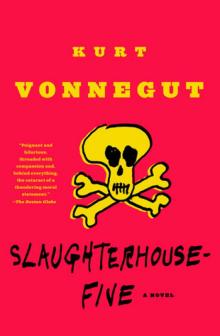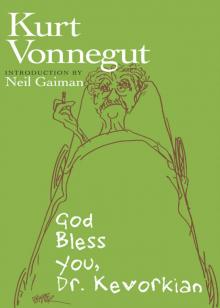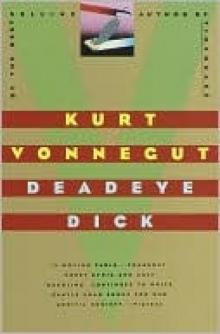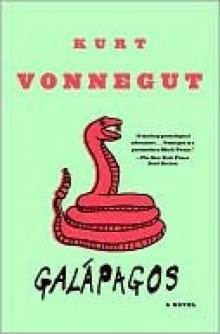- Home
- Kurt Vonnegut
A Man Without a Country Page 6
A Man Without a Country Read online
Page 6
Humor is a way of holding off how awful life can be, to protect yourself. Finally, you get just too tired, and the news is too awful, and humor doesn't work anymore. Somebody like Mark Twain thought life was quite awful but held the awfulness at bay with jokes and so forth, but finally he couldn't do it anymore. His wife, his best friend, and two of his daughters had died. If you live long enough, a lot of people close to you are going to die.
It may be that I am no longer able to joke--that it is no longer a satisfactory defense mechanism. Some people are funny, and some are not. I used to be funny, and perhaps I'm not anymore. There may have been so many shocks and disappointments that the defense of humor no longer works. It may be that I have become rather grumpy because I've seen so many things that have offended me that I cannot deal with in terms of laughter.
This may have happened already. I really don't know what I'm going to become from now on. I'm simply along for the ride to see what happens to this body and this brain of mine. I'm startled that I became a writer. I don't think I can control my life or my writing. Every other writer I know feels he is steering himself, and I don't have that feeling. I don't have that sort of control. I'm simply becoming.
All I really wanted to do was give people the relief of laughing. Humor can be a relief, like an aspirin tablet. If a hundred years from now people are still laughing, I'd certainly be pleased.
I apologize to all of you who are the same age as my grandchildren. And many of you reading this are probably the same age as my grandchildren. They, like you, are being royally shafted and lied to by our Baby Boomer corporations and government.
Yes, this planet is in a terrible mess. But it has always been a mess. There have never been any "Good Old Days," there have just been days. And as I say to my grandchildren, "Don't look at me. I just got here."
There are old poops who will say that you do not become a grown-up until you have somehow survived, as they have, some famous calamity--the Great Depression, the Second World War, Vietnam, whatever. Storytellers are responsible for this destructive, not to say suicidal, myth. Again and again in stories, after some terrible mess, the character is able to say at last, "Today I am a woman. Today I am a man. The end."
When I got home from the Second World War, my Uncle Dan clapped me on the back, and he said, "You're a man now." So I killed him. Not really, but I certainly felt like doing it.
Dan, that was my bad uncle, who said a male can't be a man unless he'd gone to war.
But I had a good uncle, my late Uncle Alex. He was my father's kid brother, a childless graduate of Harvard who was an honest life-insurance salesman in Indianapolis. He was well-read and wise. And his principal complaint about other human beings was that they so seldom noticed it when they were happy. So when we were drinking lemonade under an apple tree in the summer, say, and talking lazily about this and that, almost buzzing like honeybees, Uncle Alex would suddenly interrupt the agreeable blather to exclaim, "If this isn't nice, I don't know what is."
So I do the same now, and so do my kids and grandkids. And I urge you to please notice when you are happy, and exclaim or murmur or think at some point, "If this isn't nice, I don't know what is."
We are not born with imagination. It has to be developed by teachers, by parents. There was a time when imagination was very important because it was the major source of entertainment. In 1892 if you were a seven-year-old, you'd read a story--just a very simple one--about a girl whose dog had died. Doesn't that make you want to cry? Don't you know how that little girl feels? And you'd read another story about a rich man slipping on a banana peel. Doesn't that make you want to laugh? And this imagination circuit is being built in your head. If you go to an art gallery, here's just a square with daubs of paint on it that haven't moved in hundreds of years. No sound comes out of it.
The imagination circuit is taught to respond to the most minimal of cues. A book is an arrangement of twenty-six phonetic symbols, ten numerals, and about eight punctuation marks, and people can cast their eyes over these and envision the eruption of Mount Vesuvius or the Battle of Waterloo. But it's no longer necessary for teachers and parents to build these circuits. Now there are professionally produced shows with great actors, very convincing sets, sound, music. Now there's the information highway. We don't need the circuits any more than we need to know how to ride horses. Those of us who had imagination circuits built can look in someone's face and see stories there; to everyone else, a face will just be a face.
And there, I've just used a semi-colon, which at the outset I told you never to use. It is to make a point that I did it. The point is: Rules only take us so far, even good rules.
Who was the wisest person I ever met in my entire life? It was a man, but of course it needn't have been. It was the graphic artist Saul Steinberg, who like everybody else I know, is dead now. I could ask him anything, and six seconds would pass, and then he would give me a perfect answer, gruffly, almost a growl. He was born in Romania, in a house where, according to him, "the geese looked in the windows."
I said, "Saul, how should I feel about Picasso?"
Six seconds passed, and then he said, "God put him on Earth to show us what it's like to be really rich."
I said, "Saul, I am a novelist, and many of my friends are novelists and good ones, but when we talk I keep feeling we are in two very different businesses. What makes me feel that way?"
Six seconds passed, and then he said, "It's very simple. There are two sorts of artists, one not being in the least superior to the other. But one responds to the history of his or her art so far, and the other responds to life itself."
I said, "Saul, are you gifted?"
Six seconds passed, and then he growled, "No, but what you respond to in any work of art is the artist's struggle against his or her limitations."
REQUIEM
The crucified planet Earth,
should it find a voice
and a sense of irony,
might now well say
of our abuse of it,
"Forgive them, Father,
They know not what they do."
The irony would be
that we know what
we are doing.
When the last living thing
has died on account of us,
how poetical it would be
if Earth could say,
in a voice floating up
perhaps
from the floor
of the Grand Canyon,
"It is done."
People did not like it here.
AUTHOR'S NOTE
The full-page, hand-lettered statements scattered throughout this book, "samplers suitable for framing" if you like, are pictures of products of Origami Express, a business partnership between myself and Joe Petro III, with headquarters in Joe's painting and silk-screening studio in Lexington, Kentucky. I paint or draw pictures, and Joe makes prints of some of them, one by one, color by color, by means of the time-consuming, archaic silk screen process, practiced by almost nobody else any more: squeegeeing inks through cloths and onto paper. This process is so painstaking and tactile, almost balletic, that each print Joe makes is a painting in its own right.
Our partnership's name, Origami Express, is my tribute to the many-layered packages Joe makes for prints he sends for me to sign and number. The logo for Origami, made by Joe, isn't his picture of a picture I sent him, but of a picture by me that he found in my novel Breakfast of Champions. It is of a bomb in air, on its way down, with these words written on its side:
GOODBYE
BLUE
MONDAY
I have to have been one of the luckiest persons alive, since I have survived for four score and two years now. I can't begin to count all the times I should have been dead or wished I were. But one of the best things that ever happened to me, a one-in-a-billion opportunity to enjoy myself in perfect innocence, was my meeting Joe.
Here's the thing: Back in 1993, almost eleven years ago now, I was s
cheduled to lecture on November 1 at Midway College, a women's school on the edge of Lexington. Well in advance of my appearance, a Kentucky artist, Joe Petro III, son of the Kentucky artist Joe Petro II, asked me to do a black-and-white self-portrait, which he could then use in silk-screen posters to be used by the school. So I did and he did. Joe was only thirty-seven back then, and I was a mere spring chicken of only seventy-one, not even twice his age.
When I got down there to speak, and was so happy about the posters, I learned from Joe himself that he painted romantic but scientifically precise pictures of wildlife, from which he made silk screen images. He had majored in zoology at the University of Tennessee. Yes, and some of his pictures were so appealing and informative that they had been used as propaganda by Greenpeace, an organization trying, with scant success so far, to prevent the murder of species, even our own, by the way we live now. And Joe, having shown me the poster and his own work and his studio, said to me in effect, "Why don't we keep on going?"
And so we have, and it seems quite possible in retrospect that Joe Petro III saved my life. I will not explain. I will let it go at that.
We have since collaborated on more than two hundred different images, with Joe making editions, signed and numbered by me, of ten or more of each of them. The "samplers" in this book are not at all representative of our total oeuvre, but are simply very recent jeux d'esprit. Most of our stuff has been my knockoffs of Paul Klee and Marcel Duchamp and so on.
And since we first met, Joe has beguiled others into sending him pictures for him to do with what he so much loves to do. Among them are the comedian Jonathan Winters, an art student long ago, and the English artist Ralph Steadman, whose accomplishments include the appropriately harrowing illustrations for Hunter Thompson's Fear and Loathing books. And Steadman and I have come to know and like each other on account of Joe.
Yes, and last July (2004) there was an exhibition of Joe's and my stuff, arranged by Joe, at the Indianapolis Art Center in the town of my birth. But there was also a painting by my architect and painter grandfather Bernard Vonnegut, and two by my architect and painter father Kurt Vonnegut, and six apiece by my daughter Edith and my son the doctor Mark.
Ralph Steadman heard about this family show from Joe and sent me a note of congratulation. I wrote him back as follows: "Joe Petro III staged a reunion of four generations of my family in Indianapolis, and he had made you and me feel like first cousins. Is it possible that he is God? We could do worse."
Only kidding, of course.
Are Origami's pictures any good? Well, I asked the now regrettably dead painter Syd Solomon, a most agreeable neighbor on Long Island for many summertimes, how to tell a good picture from a bad one. He gave me the most satisfactory answer I ever expect to hear. He said, "Look at a million pictures, and you can never be mistaken."
I passed this on to my daughter Edith, a professional painter, and she too thought it was pretty good. She said she "could rollerskate through the Louvre, saying, 'Yes, no, no, yes, no, yes,' and so on."
Okay?
KURT VONNEGUT is among the few grandmasters of American letters, one without whom the very term American literature would mean much less than it does. He was born in Indianapolis, Indiana, on November 11, 1922. Vonnegut lives in New York City and Bridgehampton, New York, with his wife, the author and photographer Jill Krementz.
To see more of Kurt Vonnegut's original art, visit www.vonnegut.com.

 Slaughterhouse-Five
Slaughterhouse-Five Bagombo Snuff Box: Uncollected Short Fiction
Bagombo Snuff Box: Uncollected Short Fiction God Bless You, Dr. Kevorkian
God Bless You, Dr. Kevorkian Breakfast of Champions
Breakfast of Champions While Mortals Sleep: Unpublished Short Fiction
While Mortals Sleep: Unpublished Short Fiction Slapstick or Lonesome No More!
Slapstick or Lonesome No More! Cat's Cradle
Cat's Cradle The Sirens of Titan
The Sirens of Titan A Man Without a Country
A Man Without a Country Look at the Birdie: Unpublished Short Fiction
Look at the Birdie: Unpublished Short Fiction Bluebeard
Bluebeard Hocus Pocus
Hocus Pocus The Big Trip Up Yonder
The Big Trip Up Yonder Palm Sunday: An Autobiographical Collage
Palm Sunday: An Autobiographical Collage Jailbird
Jailbird Happy Birthday, Wanda June
Happy Birthday, Wanda June Welcome to the Monkey House
Welcome to the Monkey House Player Piano
Player Piano Fates Worse Than Death: An Autobiographical Collage
Fates Worse Than Death: An Autobiographical Collage Love, Kurt
Love, Kurt Timequake
Timequake God Bless You, Mr. Rosewater
God Bless You, Mr. Rosewater 2 B R 0 2 B
2 B R 0 2 B The Eden Express: A Memoir of Insanity
The Eden Express: A Memoir of Insanity Mother Night
Mother Night Deadeye Dick
Deadeye Dick Galápagos
Galápagos Palm Sunday
Palm Sunday We Are What We Pretend to Be
We Are What We Pretend to Be Look at the Birdie
Look at the Birdie Basic Training
Basic Training Armageddon in Retrospect
Armageddon in Retrospect Basic Training (Kindle Single)
Basic Training (Kindle Single) If This Isn't Nice, What Is?
If This Isn't Nice, What Is? Bagombo Snuff Box
Bagombo Snuff Box The Petrified Ants
The Petrified Ants Cat's Cradle: A Novel
Cat's Cradle: A Novel Fates Worse Than Death: An Autobiographical Collage (Kurt Vonnegut Series)
Fates Worse Than Death: An Autobiographical Collage (Kurt Vonnegut Series)